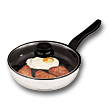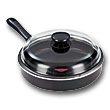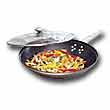 Any other utensils? You mentioned frying pans,
Freda? Any other utensils? You mentioned frying pans,
Freda?
Yes. I've not got many clear ideas of what
frying pans looked like. I think they were very solid. There were of course no
nonstick pans as there are now, so they were either iron, or, I doubt if they
were stainless steel, and they were fairly heavy I think, fairly solid to pick
up and they can still be found I think in these specialist cookshops now; but
at that time people just didn't renew their cooking utensils as they do now to
the latest fashion. They had them and they used them, and unless the handle
came off, and even then you could get somebody who could weld it back on for
you.
 

 So in your opinion then, how does that compare with the frying
pans of today? So in your opinion then, how does that compare with the frying
pans of today?
Well it had a lot of good points really. I
mean nonstick frying pans didn't come in until after the war and the nonstick
was hailed as a great invention and it wasn't until you had been using it for a
time, say 2 or 3 years, you found it was the surface which had been sprayed on
and it eventually wore off; and then you wondered where it had been going to;
had it been going into the food. And so the nonstick pans got better as time
went on they were, I think they were blasted on or something, the surfaces,
they were certainly far more long lasting and the higher a price you paid the
better a pan you got; but the basic stainless steel or iron pans are still used
I know in chef's kitchens so they must have a lot to recommend them.
|

